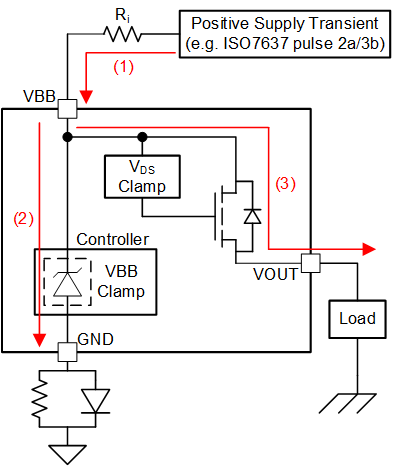SLVSFJ6 November 2020 TPS27SA08
PRODUCTION DATA
- 1 Features
- 2 Applications
- 3 Description
- 4 Revision History
- 5 Device Summary Table
- 6 Pin Configuration and Functions
- 7 Specifications
- 8 Parameter Measurement Information
-
9 Detailed Description
- 9.1 Overview
- 9.2 Functional Block Diagram
- 9.3
Feature Description
- 9.3.1 Protection Mechanisms
- 9.3.2 Diagnostic Mechanisms
- 9.4 Device Functional Modes
- 10Application and Implementation
- 11Power Supply Recommendations
- 12Layout
- 13Device and Documentation Support
- 14Mechanical, Packaging, and Orderable Information
Package Options
Mechanical Data (Package|Pins)
- PWP|16
Thermal pad, mechanical data (Package|Pins)
- PWP|16
Orderable Information
9.3.1.4 Voltage Transients
The TPS27SA08 device contains two voltage clamps which protect the device against system-level voltage transients.
The clamp from VBB to GND is primarily used to protect the controller from positive transients on the supply line. The clamp from VBB to VOUT is primarily used to limit the voltage across the FET when switching off an inductive load. Both clamp levels are set to protect the device during these fault conditions. If the voltage potential from VBB to GND exceeds the VBB clamp level, the clamp will allow current to flow through the device from VBB to GND (Path 2). If the voltage potential from VBB to VOUT exceeds VCLAMP, the power FET will allow current to flow from VBB to VOUT (Path 3).
 Figure 9-1 Current Path During Supply Voltage Transient
Figure 9-1 Current Path During Supply Voltage Transient